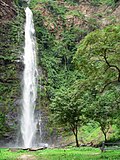| Ministry of Tourism, Arts & Culture (MoTAC) Ghana | |
 | |
 | |
| Agency overview | |
|---|---|
| Formed | 1993 |
| Jurisdiction | Republic of Ghana |
| Headquarters | |
| Ministers responsible |
|
| Website | Official Website |
The Ministry of Tourism, Culture and Creative Arts Ghana (MoTCCA) is the government ministry responsible for the development and promotion of tourism-related activities in the country. [1]


















